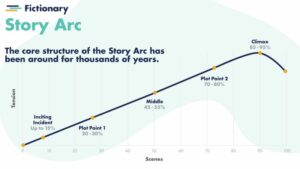
As a reader, you give a writer your trust. You are willing to invest your time and money in a story – to be entertained, to be enlightened, or just to be swept away from your ordinary world for a while.
As a writer, you want to deliver on your story’s promise to the reader. The Story Arc Template offers you a way to see your story’s structure and know that your story delivers on its promise.
Wouldn’t it be great to know you’ve got a structurally strong story that will keep readers hooked? Too much to ask, you say? Never! Because we’ve got a secret weapon: the Story Arc.
What is a Story Arc? How does it relate to Plot Structure?
A plot is more than just a series of events. Those events need to be connected through cause and effect. There are many different plot structures out there, from Aristotle’s Story Triangle (as you may guess, using three points for the structure) to the Hero’s Journey (which Vogler expanded into 12 steps within the three stages) and beyond.
Plot structures offer a way to organize our events and spark our creativity in developing our stories. Whether you are outlining, drafting, editing, or revising, a plot structure can help you ensure your story has focus.
Plot structures offer a framework that ensures the writer gives the reader what they expect.
So why use the Fictionary Story Arc as your template? First, because this structure has been researched and designed to work for your story, regardless of genre. With the Story Arc, you know you have the key elements to build your reader’s trust throughout the story.
Start with a Skeleton Blurb
Before we start digging deeper, you’ll need one magic tool: the Skeleton Blurb. This is just for you: the writer. You know your story, so this is easy. Just three parts: the protagonist, the story goal and the story stakes. You can put them together in a quick sentence that will be the touchstone for your exploration of the Story Arc Template.
The protagonist must (story goal) otherwise (story stakes). So for The Hunger Games, you might write: Katniss must win the Hunger Games otherwise she will die and her family will starve. So, what’s your story’s Skeleton Blurb? Go on, write it down. I’ll wait.
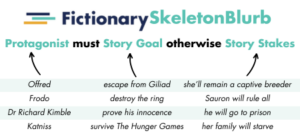
Got it? Ok, here we go.
In its simplest form, the Story Arc Template includes the inciting incident, plot point 1, the middle plot point, plot point 2, the climax and the resolution or falling action. That’s it. So how do these elements build the reader’s trust? They do that through the definitions and expectations for each element.
Let’s take a closer look:
Inciting Incident
In the inciting incident, the protagonist meets the story goal. Not in a “how do you do” way, but in a “yikes my world’s been turned upside down” way.
After this, the world is different. From this moment, the reader is wondering what will happen to the protagonist in the future. The protagonist may only feel the change and not fully recognize the story goal yet, but the reader knows and cares. The questions raised here drive the reader through the whole story since they won’t be answered until the climax.
The journey has begun for both the protagonist and the reader..
To really build the reader’s trust, every Story Arc scene should come from the protagonist’s viewpoint. After all, the reader has just committed to this journey toward the story goal with the protagonist. The reader is asking questions, ones that won’t be answered until the climax. You’ve given them a long hook to keep them going through the story. So give them this. Let them see and feel this event as the protagonist does.
And, the events in the inciting incident shape the climax (but more on that later)
Plot Point 1, AKA The Rising Action
Plot Point 1 is the moment where the choice of going back is gone. As the story breaks between Act 1 and Act 2, the protagonist must move toward the story goal, however reluctantly. In the coming scenes, the protagonist will do things more as a reaction to what is happening than as a pursuit of the story goal. There will be attempts to get the goal, but there won’t be advanced planning.
As with each of these Story Arc scenes, there will be new information about the story goal and a change in the story direction. The stakes are higher now, but the protagonist isn’t fully committed to actively getting the goal. That will come soon, but not yet.
Seen from the protagonist’s viewpoint, this scene is full of tension as the protagonist recognizes that the story goal must be attained. The story goal is important and getting there is necessary because there is no going back to the way things were before.
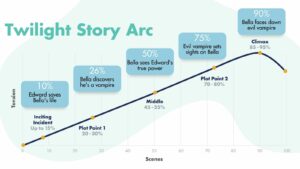
Middle or Midpoint
The middle plot point event shakes things up again. This is a moment of decision: do I want that goal? The reader trusts that they will experience this moment with the protagonist.
In this moment, something terrible or life-changing happens to the protagonist who discovers their worldview and even sense of self changes.
Will the protagonist find the strength to deal with what happened and to take matters into their own hands?
The reader feels the need of the protagonist. They must become proactive and chase the goal. The desire is truly there.
But, the reader knows there is so much more ahead and will keep reading to find out what’s next.
Every genre needs a middle plot point; it helps avoid the dreaded saggy middle. More importantly, it marks a huge change for the protagonist. Up to now, the protagonist has been moving through the world like a beginner, not knowing the rules of the game. Now, the rules are more clear, plans can be made, and the protagonist will move through the second half of the story making choices and taking action…not always the right ones, but forging ahead with a plan and a goal.
To really finesse the middle, think about how your story will end. Can you offer the reader a hint of how the climax will be resolved here in the Middle? Success? Failure? Bittersweet?
Just a thought…
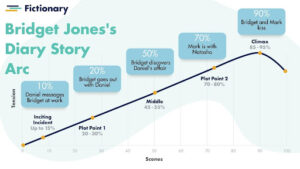
Plot Point 2
Speaking of giving hints, here is a moment to look back and create a mirror. Plot Point 1 was the break into Act 2, and Plot Point 2 is the break into Act 3. Both of these Story Arc scenes have to shift the protagonist and the reader into a new section of the story.
Since the Middle, the protagonist has been trying everything to reach the goal. Most of the attempts have been utter failures. While there has been learning and growth, this last attempt has caused havoc and now the story goal seems completely out of reach. It is just too much.
As well as the lowest point, there is a flash or moment of understanding that it is going to take a change in the protagonist or their way of thinking to get to the climax.
This is the final place where new story information can be added. From here, there will be no more revelations or flashbacks or backstory – just a rush to the climax.
And the readers will join you because they are worried the protagonist may not recover, the story goal won’t be attained, and the story stakes will come into play.
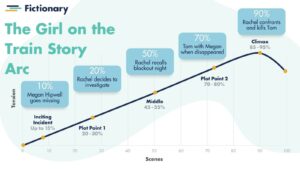
Story Climax
The Story Climax is the highest point of tension, conflict, and/or emotion. In this scene or scenes, the protagonist faces the biggest obstacle and determines their own fate.
In the Climax, the reader sees aspects that mirror the Inciting Incident, and smiles.
Best of all, the climax delivers on the story promise. The Skeleton Blurb comes through and the reader knows if the protagonist attained the story goal, or not.
The reader has a sense of completion either way, and their trust has been rewarded.
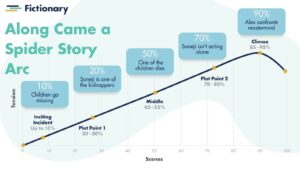
Falling Action
The climax isn’t the end. The story continues to show how the protagonist and the story world changes and reacts to the climax.
As a mirror is shone by the image of the story world at the end back to the ordinary world portrayed at the beginning of the story, the reader gets that final sense of completion and trust.
And they look for your next book – will it be out soon?
How Fictionary Works as a Story Arc Template
Once you know your Story Arc scenes, you can use them to draw your Story Arc, or you can have Fictionary do that for you. Once you import your manuscript, the software uses Natural Language Processing to suggest your story arc scenes and to draw your Story Arc. As you look over the information, you can decide if it has chosen the correct scenes, make revisions and it will redraw the Story Arc in real time.
As you are looking it over, notice where your Story Arc scenes fall within the suggested percentages. It doesn’t matter if your Arc doesn’t perfectly match the suggested arc. That gives you information to examine. Why might another scene have been chosen? Longer word count? Different POV? You have the power to decide what is right for your story and what will build your reader’s trust.
Watch as the Story Arc graph changes as you make changes within the software. No spreadsheets or rulers required.
A Couple More Examples of Story Arc Templates
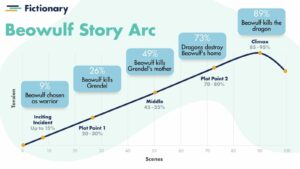
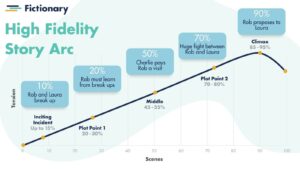
Build Confidence and Reader Trust with your Story Arc Template
The Story Arc Template gives you the power to know your story is structurally strong. Better yet, as you read through your Story Arc scenes, you can decide if that is the story you want to tell. If you are outlining or drafting, you can make changes as you create. If you are editing, you will be able to find actions you can take to make the story stronger. If you are revising, you can use the Story Arc graph to see the ride you’ve given your readers.
You’ve found the secret weapon to build reader trust and your confidence. Pretty great!
About the Author: Lisa Taylor
As a Fictionary Certified StoryCoach Editor, Lisa Taylor offers a thorough, objective structural story edit that honors your voice, recognizes and celebrates your skill, and offers clear, actionable ideas on ways to make your story shine even more. You can reach Lisa Taylor through the Fictionary Online Community.



